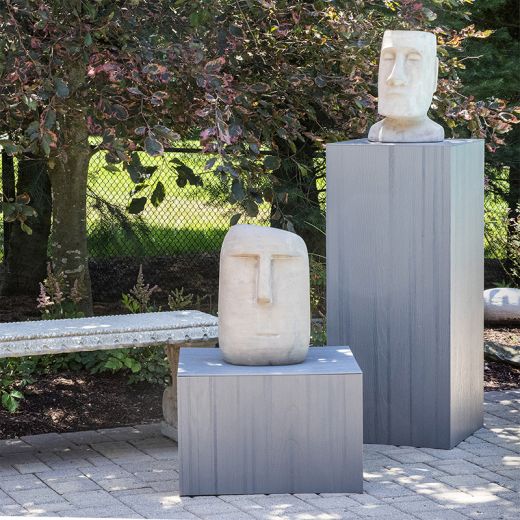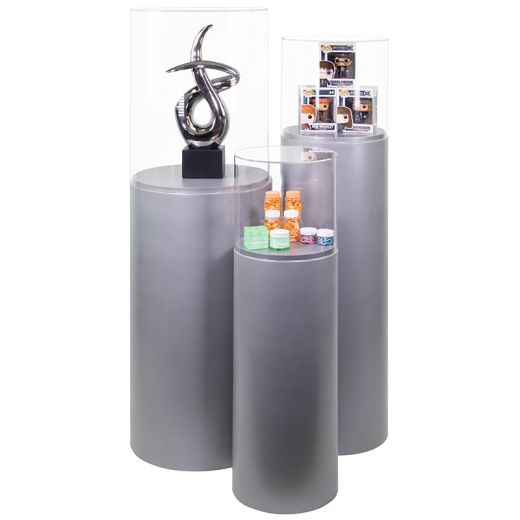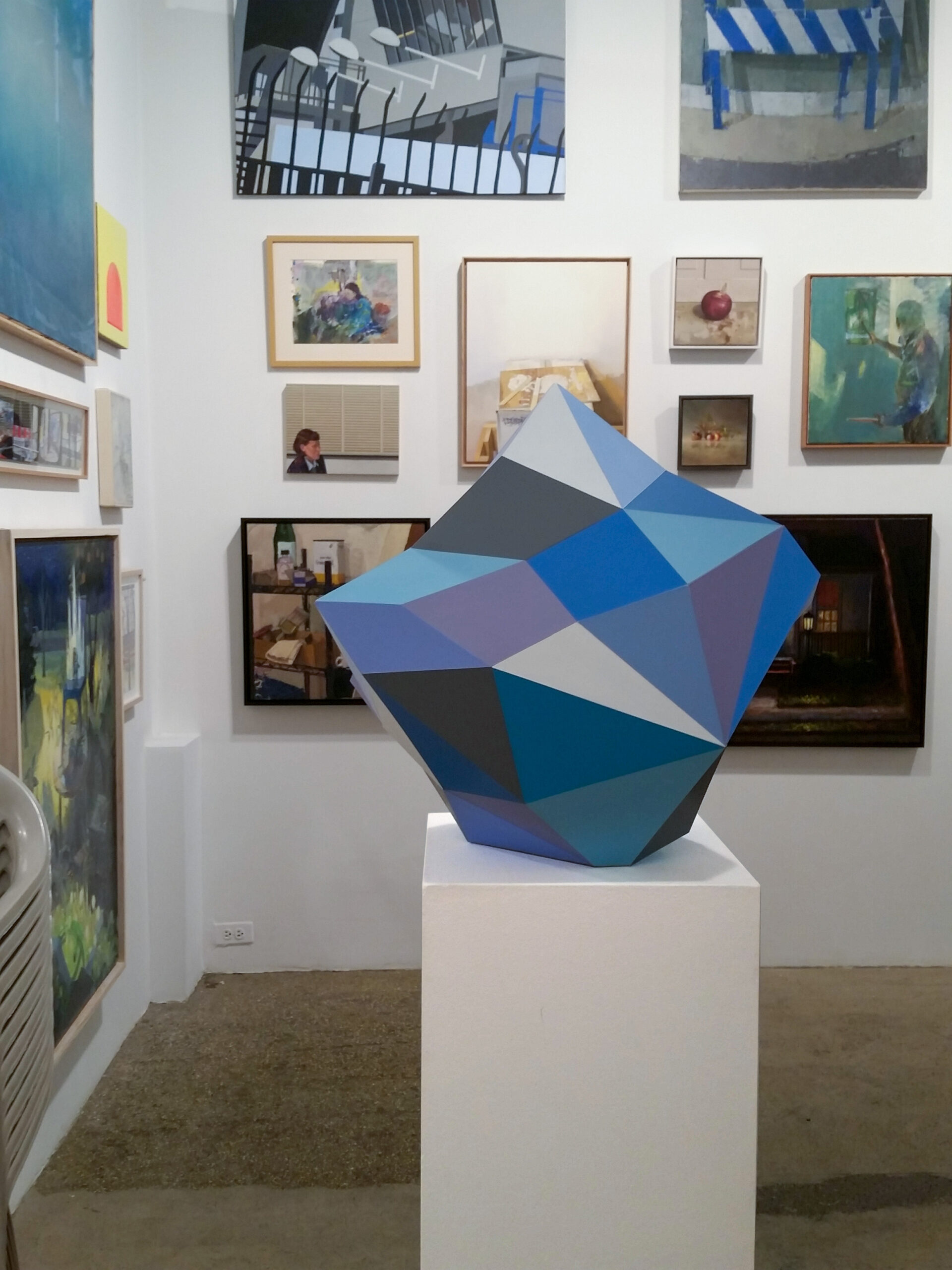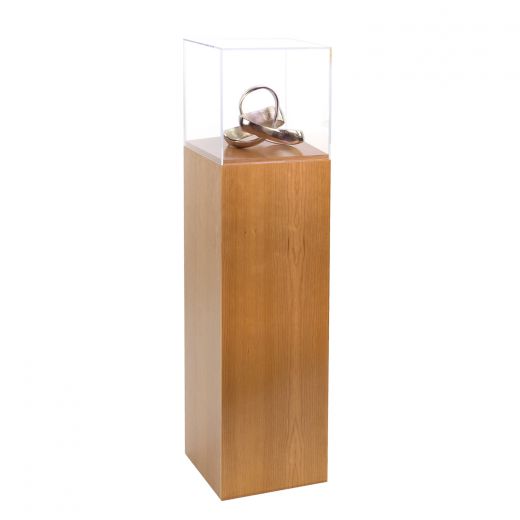
A sculpture pedestal provides an instant lift and backdrop to let the art shine. Sculptures are unique, so you want a pedestal that elevates it—literally and figuratively. Since pedestals are available in a myriad of styles, shapes, sizes, and even colors, it’s easy to get overwhelmed when selecting the best one for your sculpture.
But there are a few guidelines you can follow. Whether you are displaying them in your home, office, or at a gallery, you want to first consider the size of the room, the height of the ceiling, and placement of any furniture and doors. Then you can begin to zero in on the attributes of the pedestal itself. In this blog we discuss why you should use a pedestal as well as how to choose the best one for your sculpture.
The Benefits of Pedestals for Displaying Sculpture

Adds Height to the Piece

If a sculpture is small, a pedestal can ensure that it is placed at eye level. This enhances its visibility and allows for the piece to be more engaging in the space.
Draws Attention

Paired with the right pedestal, a sculpture becomes the center of attention. Depending on the sculpture and its surroundings, the chosen pedestal can blend in with the background, appear to be part of the art, or contrast it. Any of these strategies help the sculpture stand out.
Makes Use of the Gallery Floor

Instead of limiting artwork to the walls, pedestals make an art installation interactive by using floor space. What’s more, elevating the art creates more visual space around the piece, maximizes displays in small spaces, and prevents a crowded display. It also allows for all angles of the sculpture to be seen and admired by guests.
Protects the Sculpture

Delicate pieces and smaller artwork can easily be damaged or knocked over. A pedestal protects a sculpture by elevating it off the floor; provides a stable base or foundation, and when using an acrylic cover, deters dirt, dust, and UV rays.
How to Choose the Right Pedestal for Sculpture

There are a few things to consider when selecting a sculpture pedestal.
Consider the Color of Your Sculpture Pedestal
The pedestal should complement the artwork as well as the exhibition. There are a few ways to accomplish this.
— Match the color scheme of the room. For instance, white pedestals are a popular choice in galleries because the walls are often white or light colored and the pedestals blend in.
— Contrast the color scheme of the room. Used sparingly, but contrasting the room’s color (the floor or walls) with a color pedestal will bring the drama and draw all eyes to the sculpture.
— Complement the flooring. Choose a pedestal that matches the flooring of the room. For instance, a wood-grain pedestal on a wood floor, white pedestal on a white glossy floor, or a faux-stone pedestal on a concrete floor. This will allow the pedestal to blend into the flooring and let the sculpture take center stage.
— Eliminate color altogether. An acrylic pedestal will blend in with any background. Plus, its modern aesthetic takes a backseat to the sculpture on top of it.
Companies, including shopPOPdisplays, can provide sample swatches before ordering pedestals to ensure a good color match. shopPOPdisplays has more than 20 sample swatches to ensure you have a good color match before ordering.
Consider the Material of Your Sculpture Pedestal
Pedestals can come in a wide range of materials, including acrylic, mirrored, and stone. Here’s help for determine which is best for the space.
Laminate: Sleek and sophisticated, laminate pedestals are commonly used in art galleries, retail, trade shows, professional spaces. They can hold up to 200 pounds.
Acrylic: Clean and modern, acrylic display pedestals work in many environments. Clear acrylic pedestals disappear into their surroundings while colored acrylic pedestals make a bold statement for sculptures weighing up to 100 pounds.
Acrylic Mirror: Mirrored pedestals help reflect the aesthetic of the space. Silver, gold, and rose gold are popular choices, but the pedestals are also available in colored mirror acrylic. The quality acrylic is combined with the stability of a composite wood core for a sturdy base that holds up to 200 pounds.
Wood: Available in walnut, oak, maple, and cherry, wood pedestals deliver a warm, natural aesthetic to a room—perfect for a sculpture such as a wood carving or, for contrast, a sculpture made of metal. They can hold up to 200 pounds.
PVC Plastic: Lightweight and durable, cost-effective PVC plastic pedestals are perfect for pop-up shows, conferences, and special events. They are available in a variety of colors, are easy to transport, and can hold up to 50 pounds.
Weather Resistant: Crafted of ½”-thick FPVC PALIGHT®, a sturdy yet lightweight, long-lasting, waterproof, and rot-resistant, smooth white material; or TimberLine™, a scratch-resistant faux wood grain material, weather-resistant outdoor pedestals can be used in outdoor dining areas, coastal living areas, decks, parks, pavilions, and gardens. They also shine in indoor/outdoor spaces, such as lanais, verandas, and porches. Their weight limit is 100 pounds.
Consider the Shape and Height of Your Sculpture Pedestal
Don’t forget the artwork when selecting the right shape and height for a sculpture pedestal. Rectangle, round, tall, short…here’s what you need to know.
Rectangle – A popular choice, a rectangular pedestal provides an ample sturdy base for heavier sculptures and those with a square base. Available in a range of colors and finishes that make it a popular choice.
Round – Rounded pedestals shine in a smaller space where they take up less floor space. Their shape minimizes their appearance to blend into their surroundings and allow the sculpture to command attention.
Tall – Perfect for smaller sculptures that need a boost. You want the focal point of the sculpture to be at eye level—typically about 62 inches in height. For instance, a sculpture with focal point that is 12 to 24 inches tall should go on a 42-inch pedestal.
Short – Larger sculptures that don’t require elevation, but still raised off the floor benefit from a short pedestal as it provides a stage or base for the artwork while still positioning the artwork at eye level.
Wall – When space is at a premium, skip a traditional pedestal and mount one on the wall. Wall pedestals are designed to support more weight than a shelf, but in a sleeker form. Hung at eye level they provide a space-saving solution for smaller galleries and shows.
Consider the Length of the Show
If the show is short, such as a weekend exhibition or art fair, artists can utilize portable pedestals. They can be assembled easily with minimal tools and support up to 30 pounds of weight. Their collapsible design makes them easy move around if needed.
Consider the Lighting
Get the light right for your sculpture. Lighted pedestals with LED lights illuminate the artwork from below. This works well for small to medium sculptures or those that are transparent or semi-transparent. Being lit from the bottom boosts the drama and draws more attention to the piece. Larger sculptures, however, may require a dedicated light source to put it in the spotlight.
Other Tips for Art Curators
For all art installations, it’s important that the art has breathing room so it can truly be appreciated. Here’s how pedestals can be used to do that.
Avoid Overcluttering
To provide breathing room, sculptures should not be crowded into a corner or placed in front of other pieces of art. A white or blank wall space behind a sculpture provides a background that allows the piece to stand out.
Create Points of Focus
If displaying multiple artists, consider retail best practices. Art shop owners and curators have a few simple tricks to do this:
–Large sculptures can serve as statement pieces. Smaller sculptures can be grouped together or spread out throughout the space to create visual interest.
–Avoid placing sculptures in front of other art. It’s best to position sculpture pedestals against a white wall or uncluttered background to keep the focus on the art.
–Cluster display pedestals with sculptures by artists or theme. Borrow the retail trick of grouping in threes or odd numbers to keep the eyes moving across the art display.
–Smaller sculptures can be grouped together on pedestals of varying heights to add visual interest.
–And lastly, besides, color, lighting, and space considerations, include signage. Signage can share information such as artist, the title of the work, and material it’s made from.
Creating Sculpture Pedestal Displays with shopPOPdisplays
Finding the right sculpture pedestal takes your space, sculpture, and aesthetics into consideration. This creates harmony between the art and the environment to create an immersive experience for the viewer. With its large selection of pedestals, shopPOPdisplays makes it easy to find the right pedestal for your sculpture. Peruse our selection of display pedestals to find the perfect one today.


